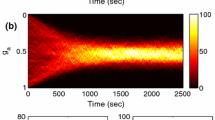Abstract
The dynamics of the learning equation, which describes the evolution of the synaptic weights, is derived in the situation where the network contains recurrent connections. The derivation is carried out for the Poisson neuron model. The spiking-rates of the recurrently connected neurons and their cross-correlations are determined self- consistently as a function of the external synaptic inputs. The solution of the learning equation is illustrated by the analysis of the particular case in which there is no external synaptic input. The general learning equation and the fixed-point structure of its solutions is discussed.
Similar content being viewed by others
References
Bi GQ, Poo MM (2001) Synaptic modification by correlated activity: Hebb’s postulate revisited. Annu Rev Neurosci 24:139–166
Burkitt AN, van Hemmen JL (2003) How synapses in the auditory system wax and wane: theoretical perspectives. Biol Cybern 89:318–332
Gerstner W, Kempter R, van Hemmen JL, Wagner H (1996) A neuronal learning rule for sub-millisecond temporal coding. Nature 383: 76–78
Hebb DO (1949) The organization of behavior. Wiley, New York
Hawkes AG (1971) Point spectra of some mutually exciting point processes. J Roy Stat Soc B 33:438–443
Kempter R, Gerstner W, van Hemmen JL, Wagner H (1998) Extracting oscillations: neuronal coincidence detection with noisy periodic spike input. Neural Comput 10:1987–2017
Kempter R, Gerstner W, van Hemmen JL (1999) Hebbian learning and spiking neurons. Phys Rev E 59:4498–4514
Kempter R, Leibold C, Wagner H, van Hemmen JL (2001b) Formation of temporal feature maps by axonal propagation of synaptic learning. Proc Natl Acad Sci USA 98(7):4166–4171
Kistler WM, van Hemmen JL (2000) Modeling synaptic plasticity in conjunction with the timing of pre- and postsynaptic action potentials. Neural Comput 12:385–405
Lamperti J (1966) Probability, 2nd edn. Benjamin, New York. (1996) Wiley, New York
Leibold C, Kempter R, van Hemmen JL (2001) Temporal map formation in the barn owl’s brain. Phys Rev Lett 87:248101
Leibold C, Kempter R, van Hemmen JL (2002) How spiking neurons give rise to a temporal-feature map: from synaptic plasticity to axonal selection. Phys Rev E 65:051915
Markram H, Lübke J, Forscher M, Sakmann B (1997) Regulation of synaptic efficacy by coincidence of postsynaptic APs and EPSPs. Science 275:213–215
Meffin H, Besson J, Burkitt AN, Grayden DB (2006) Learning the structure of correlated synaptic subgroups using stable and competitive spike-timing-dependent plasticity. Phys Rev E73:041911
Sanders JA, Verhulst F (1985) Averaging methods in nonlinear dynamical systems. Springer, Berlin
Song F, Miller KD, Abbott LF (2000) Competitive Hebbian learning through spike-timing-dependent synaptic plasticity. Nature Neurosci 3:919-926
Van Hemmen JL (2001) Theory of synaptic plasticity. In: Moss F, Gielen S (eds) Handbook of biophysics, vol 4. Elsevier, Amsterdam, pp 771–823
Author information
Authors and Affiliations
Corresponding author
Rights and permissions
About this article
Cite this article
Burkitt, A.N., Gilson, M. & van Hemmen, J.L. Spike-timing-dependent plasticity for neurons with recurrent connections. Biol Cybern 96, 533–546 (2007). https://doi.org/10.1007/s00422-007-0148-2
Received:
Accepted:
Published:
Issue Date:
DOI: https://doi.org/10.1007/s00422-007-0148-2



